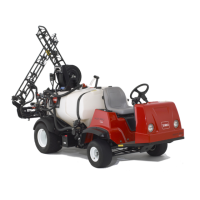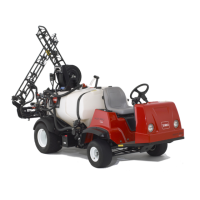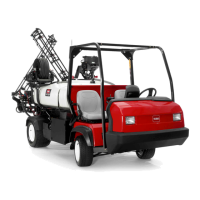Multi Pro 1200/1250 ChassisPage 8 -- 3
Adjustments
Front Suspension
Anytimethefrontwheeltoe--inischecked,thefrontsus-
pension should be c hecked as well. Incorrect suspen-
sion setting can affect steering and can cause
accelerated tire wear and scuffing.
IMPORTANT: When checking suspension, vehicle
spraytankshouldbeapproximatelyhalffullandop-
erator should be in seat.
IMPORTANT: Prior to checking front suspension,
drive the machine straight forward at least fifteen
(15) feet to allow the suspension to relax. Do not
turn steering wheel.
1. Drivemachinestraightaheadatleastfifteen(15)feet
andstoponalevelsurface.Stopengineandremovekey
from ignition switch.
2. Check attitude of both r ight and left A--arms (Fig. 1).
BothA --armsshould be levelandparallel totheground.
3. IfeitherA--armisnotlevel,checkallsuspensionand
steering components for wear or damage. If no compo-
nent wear or damage is detected, adjust suspension:
A. Chock rear wheels to prevent vehicle from s hift-
ing.Liftfrontofmachineusingajackorhoisttoallow
frontsuspensiontorelax(seeJackingInstructionsin
Chapter 1 -- Safety). Support raised machine with
jack stands.
B. Loosen and remove lock nut and cap screw that
secure axle assembly position to the frame (Fig. 2).
C. Rotateaxleassemblytoallowdifferentcapscrew
position.Rotatingaxletowardgroundincreasesten-
sion on suspension.
D. Reinstall cap screw in new position and secure
with lock nut. Torque from 130 to 150 ft--lb (176 to
203 N--m).
E. Lower machinetoground andrepeat steps1to3
as needed.
1. LH A--arm 2. RH A--arm
Figure 1
1
2
1. Axle assembly (RH)
2. Frame
3. Cap screw
4. Lock nut
Figure 2
4
1
2
3
130 to 150 ft--lb
(176 to 203 N--m)
Chassis

